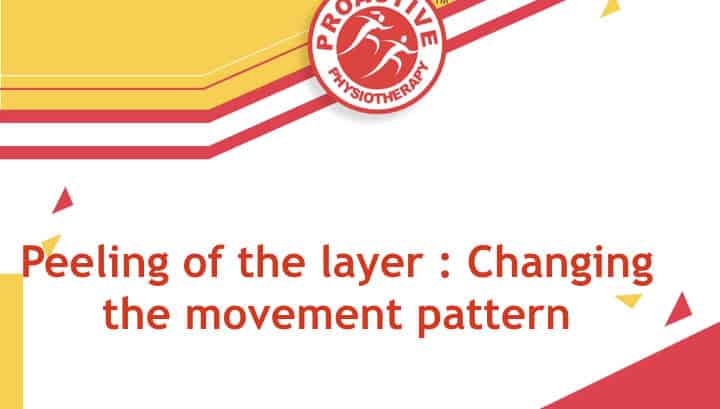Peel off the layers: changing movement pattern
The main complaint for this patient was shoulder and neck pain, with restricted range of movement of the shoulder joint. These issues about more than 5 yrs. No investigations had given them answers to resolving the issues.
The pain started after long hours of desk-based work for several hours. The patient had no other medical conditions. No accidents. No operations.
The only pointer in the patient history was the desk-bound work 5 years ago., the first priority is to determine what the core is doing . But, when there’s a lifestyle factor of sitting a lot, the Posterior Oblique Subsystem of the body is typically affected. This involves the largest muscles of the body: the Gluteus Maximus, connected to the opposite Latissimus Dorsi via the Thoracolumbar Fascia.

The Thoracolumbar Fascia is a common source of lower back pain if the Gluteus Maximus and Latissimus Dorsi aren’t working properly. However in this case, the main complaints were right-sided neck and shoulder pain, and left-sided ankle pain. No lower back pains. It’s quiet interesting complain which you never thought may be.
Could it be that the ankle and neck/shoulder pains were connected? yes, through the Posterior Oblique Subsystem. Just look at that picture above; if the left Gluteus Maximus isn’t working efficiently, something down that left leg is likely to suffer .
The first consultation started with movement assessment, giving clues that there was something related to the core to address first and rotational impairment also . The Gluteus Maximus and Latissimus Dorsi are a part of the assessment .
We found that both Gluteus Maximus muscles were not firing properly when performing manual muscle testing. The patient was also unable to meet pressure from a perturbation test, which involves pushing them backwards when standing.
 As the Gluteus Maximus had become inefficienct, the Tibialis Anterior had been compensating. There was more tightness on the left leg, with some muscle adhesions with the other shin muscles.
As the Gluteus Maximus had become inefficienct, the Tibialis Anterior had been compensating. There was more tightness on the left leg, with some muscle adhesions with the other shin muscles.
Releasing the muscle tissues of the shins . we were activate the Gluteus Maximus and the patient was able to comfortably meet the pressure of the perturbation test (i.e., they easily managed to resist the me pushing them backwards).
In the upper body, using manual muscle testing, we found that the right Latissimus Dorsi was inefficient .the Latissimus Dorsi depresses the scapulae along with the Pectoralis Minor and Serratus Anterior muscles. Opposing this action, the Upper Trapezius and Levator Scapulae elevate the scapulae. So, when such a large muscle as the Latissimus Dorsi stops doing its job, something else pays the price for that.
All the above muscles were tight, and some were causing pain. But, that doesn’t mean they should all be released.. When testing the right Latissimus Dorsi and the Upper Trapezius, The Pectoralis Minor was very tight and the right shoulder joint was essentially locked down.
The Pectoralis Minor also protracts the scapulae which was the main reason for the limited range of movement they had in the shoulder joint. Just try to roll your shoulder forward and raise your arm straight up in front of you and above your head. Probably won’t get far, but if you relax your shoulder back and down, see what happens. That’s one of the things the Latissimus Dorsi helps with.
 We apply ex’s for activating the Latissimus Dorsi, the Pectoralis Minor released very quickly and the tension melted away, the shoulder moves freely as compare before.. The patient felt a lot better and the range of movement in the shoulder joint improved significantly.
We apply ex’s for activating the Latissimus Dorsi, the Pectoralis Minor released very quickly and the tension melted away, the shoulder moves freely as compare before.. The patient felt a lot better and the range of movement in the shoulder joint improved significantly.
The patient was given homework to Active myofascial release to the shin muscles (Tibialis Anterior) and pectoralis minor. activate the Gluteus Maximus and latissmus dorsi.
When we met up for a second session a few weeks later,because we require to develop proper movement pattern. We examine the patient again and we found satisfactory outcome from our first session and we address the another pattern that their brain had learned due to the inefficient latissimus Dorsi.
We found that the right Serratus Anterior was also overactive, but in a relationship to the right Upper Trapezius, which was still causing tension in the neck. So, although the Upper Trapezius had been a source of pain and discomfort for about 15 years, it was actually inefficienct .
Interested readers can read more about this click here
The client was given homework to release the right Serratus Anterior with self-massage, followed by activation of the right Upper Trapezius.
Conclusion : :
Hopefully the examples above give a better picture and what kind of issues it can help. I also hope that the examples are motivational.
Moreover, we also incorporated breathing treatment Therefore, those things need to be resolved first, so it typically takes several sessions before significant change can be observed for more complex cases.
Image courtesy : compete anatomy google search




Leave a Reply
Want to join the discussion?Feel free to contribute!